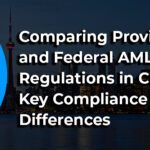
Comparing Provincial and Federal AML Regulations in Canada: Key Compliance Differences
April 29, 2025
The Revolutionization of AI & Gamification: A Look into the Future of Compliance Training
May 5, 2025Canada is ramping up its efforts to combat financial crime, and for Money Services Businesses (MSBs) and Payment Service Providers (PSPs), keeping up isn’t an option—it’s critical. FINTRAC, Canada’s financial watchdog, has rolled out tougher AML directives to strengthen reporting requirements, boost transparency, and align with global Anti-Money Laundering (AML) and Counter-Terrorist Financing (CTF) standards.
What does this mean for your business? Stricter compliance rules, tighter record-keeping, and increased risk oversight. But no stress—we’ve got you covered. This guide unpacks FINTRAC’s latest regulations, key compliance strategies, and a step-by-step roadmap to keep your business ahead of the curve in 2025 and beyond.
1.Understanding FINTRAC’s New Reporting and Record-Keeping Rules
Under FINTRAC’s latest directives, MSBs and PSPs ought to strengthen their AML programs to comply with tighter reporting and record-keeping rules.
Key Updates for 2025
- Expanded Suspicious Transaction Reporting (STRs) – Businesses must identify and report suspicious transactions more proactively, including transactions linked to virtual assets and high-risk jurisdictions.
- Lower Threshold for Large Virtual Currency Transactions – Any digital asset transactions exceeding CAD 10,000 now require reporting, aligning with FATF recommendations.
- Real-Time Record-Keeping Requirements – MSBs and PSPs must maintain detailed transaction logs, including customer identification and risk assessments, for at least five years.
Recent Enforcement Action
In 2024, FINTRAC issued penalties exceeding CAD 5 million against multiple financial institutions and fintech firms for failing to meet AML reporting standards, reinforcing the importance of proactive compliance. Learn how MSBs can meet FINTRAC’s compliance requirements
This isn’t the first time FINTRAC has taken strong enforcement action. In a striking case, two of Canada’s largest real estate companies were fined for non-compliance, highlighting the regulator’s increasing scrutiny across industries. Is this a wake-up call for the sector? While years have passed, the case remains a critical reminder that businesses cannot afford to be complacent. Revisit the details and key takeaways in our previous article here.
2. Fundamental AML Strategies for MSBs and PSPs
To comply with FINTRAC’s enhanced AML directives, MSBs and PSPs should adopt risk-based compliance strategies.
Essential AML Practices
- Enforce Robust KYC and Customer Due Diligence (CDD) – Verify customer identities using biometric authentication, AI-driven risk assessment, and continuous and consistent due diligence.
- Improve Transaction Monitoring Systems – Use AI-powered fraud detection tools to detect and raise alarm on suspicious patterns and unusual cross-border transfers.
- Digitize Suspicious Activity Reporting (SARs) – Ensure instanteneous alerts and automated reporting to FINTRAC for transactions linked to high-risk jurisdictions.
- Ensure staff receive frequent AML training – Provide ongoing education on compliance duties, fraud trends, and legal consequences.
3. Key Regulatory Trends Impacting Canada’s AML Framework
As financial crime risks grow, Canada updates its AML rules in line with FATF standards.
What’s Shaping AML Compliance in 2025?
- Reinforcing Beneficial Ownership Transparency – Financial institutions and MSBs are now required to report and verify Ultimate Beneficial Ownership (UBO) details under the latest regulations.
- Stricter rules for virtual assets – Canada tightens oversight on crypto transactions.
- to stop money laundering and illicit finance.
- Concentrate on Cross-Border Payment Compliance – Stronger rules for cross-border payments and fintech PSPs.
4. 2025 Compliance Roadmap for MSBs and PSPs
To remain compliant with FINTRAC’s latest AML directives, MSBs and PSPs should implement the following compliance roadmap:
Immediate Steps
- Review FINTRAC’s latest updates and align internal policies with new requirements.
- Assess current AML compliance programs and identify gaps in reporting obligations.
- Update KYC and CDD protocols to ensure stronger identity verification.
Mid-Term Actions
- Implement RegTech solutions to automate transaction monitoring and suspicious activity detection.
- Regularly review AML programs to identify gaps and improve compliance.
- Collaborate with banks and regulators for smoother cross-border transactions.
Long-Term Compliance Strategy
- Engage with regulatory consultants to stay ahead of policy changes.
- Adopt AI-driven AML technology for continuous compliance monitoring.
- Ensure compliance training programs are conducted regularly to educate employees.
5. Looking Ahead: What’s Next for AML Compliance in Canada?
Canada’s AML landscape is evolving fast, and only the most prepared businesses will stay ahead. With stricter FINTRAC directives, MSBs and PSPs must sharpen their compliance strategies, enhance transaction monitoring, and fortify risk controls.
At Paycompliance, we don’t just help you meet the minimum requirements—we position you for long-term success. Our expert-led solutions help you build a strong AML program, maintain accurate reporting, and stay audit-ready at all times. Stay ahead of the curve. Stay compliant. Stay unstoppable. Get in touch today !



